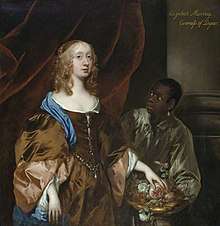Elizabeth Maitland, Duchess of Lauderdale
Elizabeth Maitland, Duchess of Lauderdale, 2nd Countess of Dysart (née Murray; 28 September 1626[1] – 5 June 1698) was a Scottish noblewoman. In her own right she was the Countess of Dysart and from the date of her remarriage in 1672 the Duchess of Lauderdale. She is famous for the political influence she held, which was unusual for women of the period, and for her support for Charles II during his exile, as a member of the secret organisation known as the Sealed Knot.

The Duchess of Lauderdale | |
|---|---|
%2C_by_Peter_Lely.jpg) Elizabeth Murray, by Sir Peter Lely, circa 1648 | |
| Born | 28 September 1626 |
| Died | 5 June 1698 (aged 72) Ham House |
| Buried | Petersham Parish Church |
| Spouse(s) | Sir Lionel Tollemache John Maitland |
| Issue | |
| Parents | William Murray, 1st Earl of Dysart Catherine Bruce |
Early life
Murray was the eldest of the five daughters of William Murray, 1st Earl of Dysart, a close friend and Gentleman of the Bedchamber of Charles I; and his wife Catherine Bruce.[1] Her father ensured that she received a full education, which was unusual for women of the period.[2][3]
Because of the English Civil War her father was delayed in finding her a husband but in 1648 she married Sir Lionel Tollemache. The couple had eleven children, five of whom lived to adulthood, including Lionel Tollemache, 3rd Earl of Dysart and Thomas Tollemache; their eldest daughter, Elizabeth Tollemache, married Archibald Campbell, 1st Duke of Argyll.[4]
Later life
Elizabeth did not want a quiet domestic life and based herself at her family home, Ham House near Richmond by the Thames, today in London, then in Surrey, which she spent much time and money redeveloping.[5] She was acquainted with the Parliamentarian Oliver Cromwell during this period and the friendship provided a cover for her own Royalist tendencies. In 1653 she joined the secret Royalist organisation, the Sealed Knot.[2] She was in correspondence with exiled supporters of Charles II and even visited Europe to see the king himself.
Upon her father's death in 1655 she inherited his titles, becoming suo jure Countess of Dysart and Lady Huntingtower. In September 1658 one of her neighbours, Judith Isham, joked about her new title, writing that people "call her my Lady Dessert, she is soe takeing, expressing extraordinary sivility to every person."[6]
In 1660, when Charles II resumed the throne, he rewarded Elizabeth with an annual pension of £800 (equivalent to £100,000 in 2019).[2] Her enemies accused her of witchcraft because of her political influence.[1]
.jpg)
In 1669 her husband Lionel died in France. It is suspected that very soon after this she became the mistress of John Maitland, 1st Duke of Lauderdale,[2] the Scottish noble and politician, whom she eventually married in 1672, upon his own wife's death. He was a member of the notorious Cabal Ministry of Charles II and amongst his titles was that of Baron Petersham. The pair were known for their influence, wealth, and extravagance.[3]
Upon John's death in 1682 Elizabeth entered into a legal dispute with her brother-in-law over her late husband's debts and funeral expenses.[2]
Death
The Duchess of Lauderdale died, at the age of 72, on 5 June 1698 at Ham House.[7] She is buried with other members of the Dysart family in a vault under the chancel of Petersham Parish Church.[8]
In literature
Elizabeth Murray was first described in popular literature in the 1975 book by Doreen Cripps, Elizabeth of the Sealed Knot. [9] She is also the subject of the novel Royalist Rebel, by Anita Seymour published by Claymore Books in 2013 [10].
References
- "Elizabeth Murray in Women in World History". Women in World History: A biographical encyclopedia. 1 January 2002. Archived from the original on 6 November 2012. Retrieved 6 July 2011.
- Rosalind K. Marshall (2004). "Elizabeth Murray in ODNB". Oxford Dictionary National Biography. Retrieved 6 July 2011.
- "Benedetto Gennari: Elizabeth Murray, Duchess of Lauderdale, 1626 - 1691 (About 1679)". National Galleries Scotland. Retrieved 4 February 2017.
- "Baronage of Duddingston History". Baronage.co.uk. 2005. Retrieved 6 July 2011.
- "Ham House". National Trust. Archived from the original on 19 July 2011. Retrieved 6 July 2011.
- Nadine Akkerman, Invisible Agents (Oxford, 2018), p. 132.
- "Biography of Elizabeth Murray". Stanford.edu. Archived from the original on 6 October 2011. Retrieved 6 July 2011.
- "Churchyard (Petersham Village, Richmond Surrey)". Retrieved 11 July 2011.
- Cripps, Doreen (1973). Elizabeth of the sealed knot : a biography of Elizabeth Murray, Countess of Dysart. Roundwood Press. ISBN 0900093439.
- "Royalist Rebel". 28 January 2013.
| Peerage of Scotland | ||
|---|---|---|
| Preceded by William Murray |
Countess of Dysart 1655–1698 |
Succeeded by Lionel Tollemache |